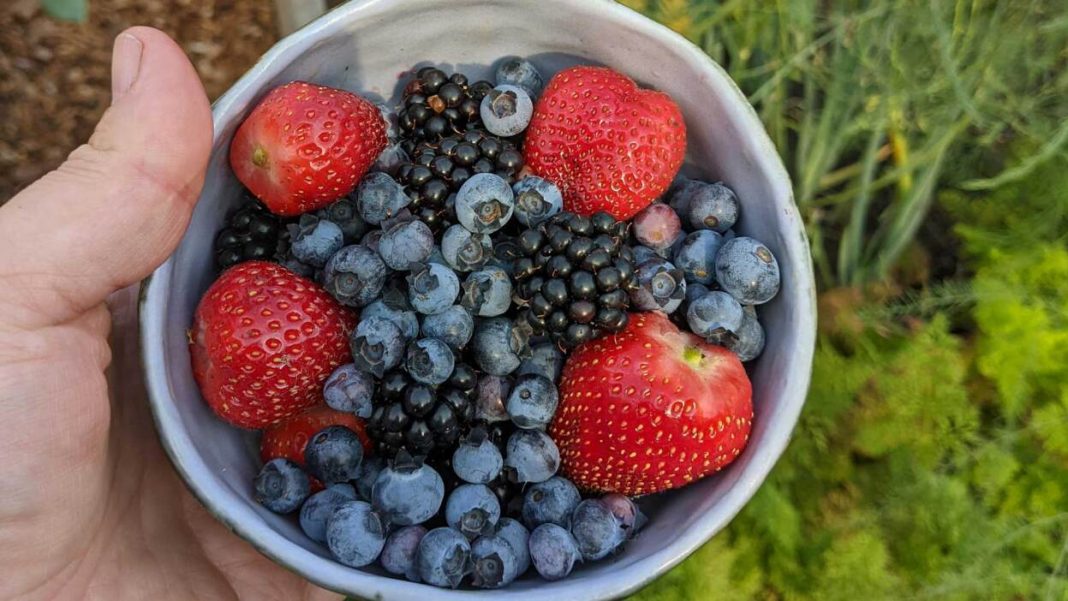Six years ago, I bought a few fig trees on a lark. Each year, the trees get bigger, and produce a few figs I get excited about, and by mid-summer, the plant has dropped them and goes back to just existing. Why do some plants produce fruit prolifically while others can’t seem to set any fruit at all? Why do I wait all summer for tomatoes and then they all ripen the same week? The answer to all these questions has to do with pollination and making smart choices about what varieties you grow, where, and how many you plant.
Even self-pollinating plants do better in pairs
All fruit and vegetables require pollination, which is the transfer of pollen from the stamen of a male flower to the stigma of a female flower. Yes, we’re talking about flower sex. Except the work is done by the wind or pollinators like bees, birds, flies, wasps, and beetles. In many cases, like vegetables, plants can be self-pollinating, which means one plant bears both female and male flowers, and they can pollinate each other. This is also true of fruit trees like elderberry, peach, and pomegranate. When purchasing a fruit tree, the label will tell you if the plant is self-pollinating or requires a mate. What the label doesn’t say is that even self-pollinating plants do better when there’s another one nearby. This is true of tomatoes, squash, cherries, and all other self-pollinating plants. The more pollen nearby, the better.
Some plants require mates
Corn needs to be planted in blocks, no less than six feet by six feet, to really be successful. The wind carries the pollen from the tassels onto the corn silks, and if enough pollen makes contact, an ear is formed. Your olive tree must have another olive tree within 25 feet, regardless of whether it’s the same kind of olive in order to bear fruit. Kiwi vines are either male or female, and to get kiwi fruit, you’ll need both. It’s vital to know which plants can’t be planted singularly and ensure that when choosing what you’ll plant, you plan accordingly.
Choose varieties with different ripening dates
It’s a real bummer to wait for peppers all summer and then have them all ripen in the same week, but if you only plant one kind of pepper, that’s likely to happen. You can create longer windows of harvesting by choosing different varieties—some that ripen early, and some that ripen mid or late season. For instance, blueberry varieties are always marked by when they ripen during the season. If you can fit three bushes, getting an early-, a mid-, and late-ripening variety will ensure longer blueberry harvests. Strawberries come in two types: June-bearing, which are smaller, sweeter strawberries only ripening in June, or ever-bearing, which produce larger berries that will ripen all summer. Within each type are many varieties that will bear early, mid, or late within their season. Mixing and matching means you could have strawberries all summer. The same is true for raspberries, with some types even bearing fruit through the fall. Cherries, peaches, apples, and even cauliflower varieties all can be staggered so you get as long a season as possible.
Choose varieties for your planting zone
Everyone in the U.S. has a USDA planting zone, and it’s likely that it changed last year. These zones represent frost dates and expected lengths of growing time in the summer. If you want plants that produce, you have to grow plants that are designed for your growing zone. I have a Meyer lemon tree I nurse like a baby and cart indoors for the winter, but it doesn’t surprise me that it doesn’t grow very well because I live in the Pacific Northwest. My prolific raspberries wouldn’t survive the summer in Phoenix, where that Meyer lemon longs to be.
You also need to consider regional types of pests or blight. For instance, if you live someplace with prolific peach leaf curl, you want to buy varieties that are peach-leaf-curl free. Your local nursery will know what the local threats are and are the most likely to have varieties that have been bred to resist them.
Plant appropriately for the space you have
A plant, like my sad figs, that doesn’t have the right amount of space to grow, is going to have challenges. This can either be a space too small for it, a lack of support, poor soil or drainage, or lack of water. It can also be a space that is too large, like a small plant in a large planter, or without shielding plants around it, so wind exposure is an issue.
Proximity also matters. If you plant squash close together, they will cross pollinate, which is a big problem because you get franken-squash.
Use your resources
Between my neighbor’s house and mine are sixty feet of kiwi bushes, both female and male. The owners of our homes bought them together 30 years ago so both could benefit. You can work with your neighbors like that to coordinate plants that work for you both, but you don’t technically need permission. If you see your neighbor has an elderberry bush, you can get one, plant it nearby, and you both benefit; there’s no possible harm to either. Every pollinator-friendly flower you plant benefits everyone in the neighborhood.
While there are other inputs that matter—like the pH of the soil, the nutrition of the soil, watering, weather, whether you are thinning your fruit or protecting it from pests—the fundamental considerations for choosing what you’ll plant are easier. Know what kind of pollination is required, how much space you have, and what your zone is.
